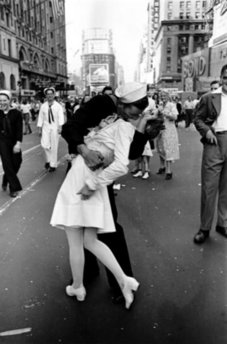PEARL HARBOR DAY -- December 7, 1941
Separately, between November 10 -18, under the command of Vice Admiral Chuichi Nagumo, a Japanese Naval Fleet consisting of six aircraft carriers with 360 planes and 25 support vessels, left Kure Naval Base in Japan to assemble near the Kurile Islands on November 22, 1941, as a military striking force.
On November 26, the Strike Force moved out to position themselves, arriving some 275 miles northwest of Hawaii on December 6. This was a major strategic military movement on their part, as it was from there that they launched their surprise aerial attack on the United States naval base at Pearl Harbor on Oahu Island, Hawaii, on December 7, 1941.
Hawaii Operation, Operation Z, as it was called by the Japanese Imperial General Headquarters, launched its first strike December 7, 1941, at 0600 hours (6 AM in the morning - local time, Hawaii) resulting in the appearance of the first dive bomber over Pearl Harbor at 7:55 AM. 49 bombers, 40 torpedo planes, 51 dive bombers, and 43 fighter planes made the first wave of attacking aircraft ~ with 54 bombers, 78 dive bombers, and 36 fighter planes to follow in the second wave.
The deadly attack continued from 7:55 AM until 9:45 AM, destroying much of the American Pacific Fleet, knocking out most Hawaii based combat planes, claiming over 2,400 lives, and leaving behind over 1,300 wounded. (Please note that exact casualty/wounded figures and specifics on damaged/destroyed equipment will be found with minor variations dependant upon the official source from which they are taken.) Most sources state that the Japanese sank or destroyed nineteen ships, including all eight of our battleships (four sank, four damaged), three light cruisers, three destroyers, and several support vessels. Estimates of aircraft loss are given at 164 destroyed and 128 damaged. Horrifically, sources state 2,334 soldiers, sailors, and Marines killed along with 68 civilians; and 1,382 wounded. (US: Army KIA 222, WIA 360 ~ Navy KIA 2004, WIA 912 ~ Marines KIA 108, WIA 75 ~ CIVILIANS: KIA 68, WIA 35).
The first attack wave was commanded by Captain Mitsuo Fuchida; the second by Lieutenant Commander Shigekazu Shimazaki; a third, intended to destroy fuel storage tanks (containing 4.5 million gallons of fuel oil), torpedo storage areas, and most repair and maintenance facilities on the island was not launched, as the Japanese Force headed homeward fearing a counter attack to be immanent. Sources state that the Japanese lost to be 65 men and 29 planes.
Our American commanding officers on Oahu at the time of the attack were: Commander in Chief of the US Pacific Fleet, Rear Admiral Husband E. Kimmel, and our US Army Commander for Hawaii, Lieutenant General Walter Short.
President Franklin D. Roosevelt was to deam the date of this attack the "date which will live in infamy", as he addressed a joint session of Congress (and our nation via radio) at 12:30 PM on December 8, to request a Declaration of War against Japan. By 4:00 PM both the Senate and House had given vote, the Senate responding with a unanimous vote in support of the war ~ the House with only one desending vote by pacifist Jeanette Rankin from Montana. President Roosevelt then signed the declaration, bringing the United States into World War II. You can see Roosevelt's original document (there is also audio) at:
http://docs.fdrlibrary.marist.edu/ODDECWAR.HTML
The Japanese strike on Pearl Harbor was meant to destroy any possible threat the United States Navy's battleship force stationed in the Pacific might pose to the Japanese Empire's expansion program (expansion and conquest). It resulted in shocking Americans, unifying our country, and ending all isolationist-interventionist debates and positions people held in relation to the War (which had actually been started by Germany in March of 1938 when it began occupation of Austria and then Czechoslovakia.)
Because of treaties signed between the nations known as the Axis powers (Japan being one), the attack against Pearl Harbor brought the United States into World War II, joining with the Allied powers.
Military volunteers came by the thousands, the draft which was established by the Selective Service Act of 1940 was implemented, items on the home front became rationed (gasoline, sugar, butter, rubber, nylon, coffee, tea, etc.) so the war effort would have all that was needed, the auto industry stopped making cars and started making vehicles and planes for the war effort, women took men's places in the workforce that had gone to fight. America was united and the 'war cry' of our people was, "Remember Pearl Harbor"!
The 2009 Presidential Proclamation for Pearl Harbor Remembrance Day can be found here: http://www.whitehouse.gov/the-press-office/presidential-proclamation-national-pearl-harbor-remembrance-day
~ Rev. Lin


